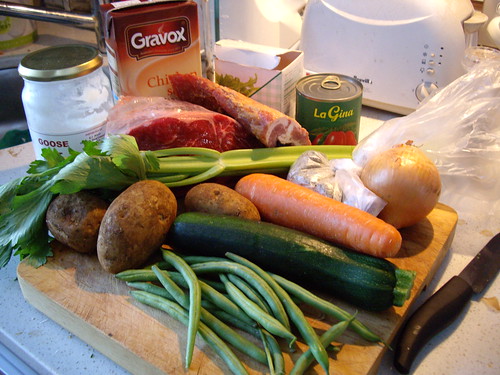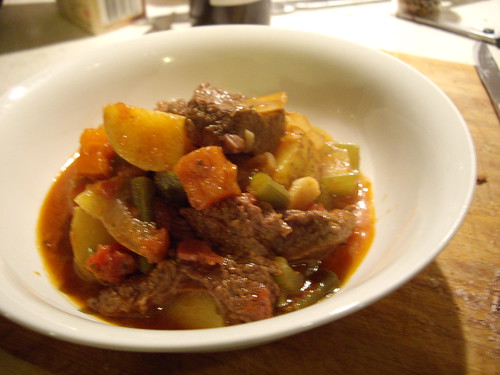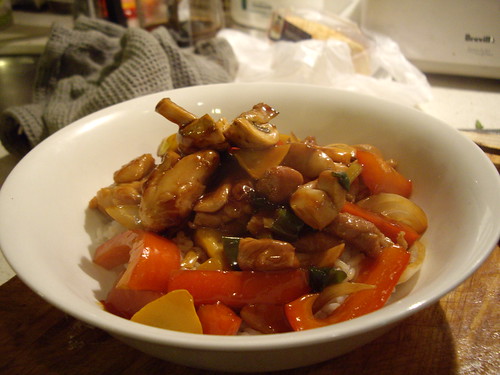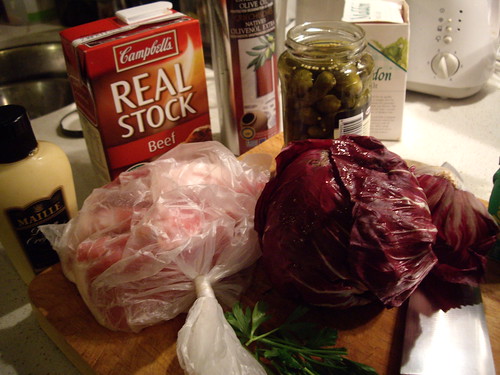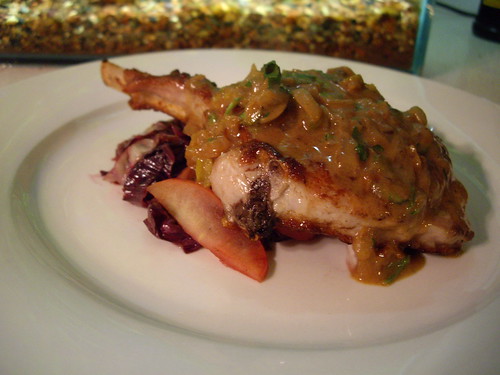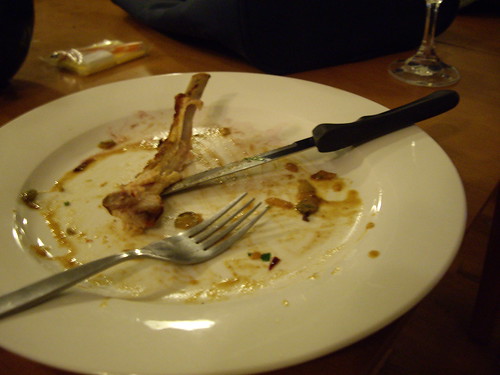As someone who has been known to decide on a dish to cook only about half-way through cooking it, it's a very different way of looking at food.
But, on the other hand - the whole one pot thing. Small inner city kitchens do not lend themselves to extravagant meals that require a stock to be bubbling, sides cooking, mains in the oven, and another two or three stations of prep. Oh for one of those Hollywood room-sized kitchens with a chopping island the size of a... well, island.
A lot of the one-pot cooking I do tends to be on the faster side - chop vegetables, throw into large pot with oil or goose fat, saute for a metric bit, then cover with stock and simmer for an hour. But just a little more time spent on prep, ingredients and cooking time can deliver a fantastic dish.
Beef casserole
As usual, our Feedbag delivery came through with some great stuff, including a chunk of sirloin roughly the size of my girlfriend's head. It was a lovely, marbled piece of meat. There was also the usual selection of market fresh veg, and the Feedbag run before, which my girlfriend went on (note, girlfriends are tetchy that time of a morning), we scored a huge bag of 'souvlaki mix'.
We've had this stuff before, and it's an awesome pre-mixed herb and spice powder. The only thing - no one's quite sure exactly what's in there. Undoubtedly there's salt and oregano, and some debate over pepper, lemon or lemon pepper. I think there's more to it, though - the flavour is a touch more complex. Maybe some thyme, or onion powder, it's hard to tell. Regardless, it's extremely tasty, so it seemed the perfect compliment to the beef.
ingredients
Chunk of sirloin
potatoes
green beans
carrot
zucchini
onion
celery
tinned tomato
bacon bones
chicken stock
goose fat
In terms of directions, it doesn't get simpler. There is, however, one complication to be mindful of - the state of your meat.
If you've ever wondered why beef dishes can be so tender and wonderful in a restaurant, but so chewy and disappointing at home... it's all in the prepping of the meat. More specifically, it's in the removal of connective tissue.
Not all connective tissue, however. Good connective tissue, the stuff that surrounds each muscle fibre, is made from collagen. Collagen breaks down with slow heat, and adds that silky fattiness that makes a real gourmand water at the mouth and go weak at the knees. The bad stuff, though, is made from elastin, and this doesn't break down. In fact, it gets tough and will actually curl and warp the meat as it cooks.
So how do you tell the bad stuff?
Well, it's usually the very obvious silver membrane running through a cut of meat. This is the stuff that connects two different muscle groups - it has to be tough stuff, to stop muscles from separating. Good for walking around without tearing yourself limb from limb, bad for cooking. Thankfully, it only takes a bit of effort to remove, and when you get really good at it, you won't waste a bit of meat.
I'm... not that good at it yet. You need a really sharp knife, too, but the trick is to part the two layers of meat gently apart as you stroke the edge of the blade along the grain of the meat. If you've a cut of meat with the membrane running through the center, you'll need to trim twice - once to halve the meat into a good bit and a membraned bit, and then trim again to remove the membrane altogether. Yes, there will be a bit of wastage, but practice will make perfect.
More importantly, a bit of wastage is worth it for the end result. So, with the dreaded silver membrane removed, what do you do for this stew?
Simple. Cube your sirloin into good sized chunks, and lay flat on a tray or pan. Sprinkly with your souvlaki mix - or whatever herb-spice combo you want, really - pat the mix into the meat, then turn the pieces. Repeat - spices, pat etc - and then let sit while you get chopping the veg. Chop roughly and not too small, otherwise you'll end up with beef in vegetable soup. Do chop the bacon bones carefully, though - relatively small, and be careful to avoid too much bone.
With everything chopped up, get a tablespoon or so of goose fat melted in a heavy bottomed pot, and brown the beef. And since we're being all educational, no, you don't sear or brown meat to "seal in the juices" - cooking meat actually cooks the juices off! The reason you do brown is to caramelise the beef, adding an important flavour element.
Once all the beef is nicely browned (it should be rare at this stage, and you'll need to make sure by popping a piece into your mouth - you like rare beef, right?) take the pot off the heat, and add everything else. You don't want to cover the ingredients with the stock, but add just enough liquid that you can see it just below the uppermost layer of ingredients. Give it all a mix, then bung in an oven pre-heated to about 170 degrees.
Cooking for a few hours. Stab a carrot to test if it's ready. If not, up the temperature and cook for a bit longer. Once it's ready, plate in a bowl by itself, or add to a plate of boiled white rice, or even a nice creamy mash if you're really feeling like a lot of potato.
Okay, not my best photo. But man, it was a very good bottle of wine.
My hazy focus aside, this is serious business. This is cooking at not only its simplest and most basic, but also illustrative of the simple tricks you can use to really lift a dish. Cooking something like this in goose fat delivers a triple-threat of culinary oomph: it's flavoursome, silky from the goose fat, and silkier again from the broken down fat in the beef.
It's like eating... something really expensive and melted.
But the real star, the Jewel in the Silky Crown, is that beef. Tender. Fall apart on your fork. Melt in your mouth.
Happy. In your pants.
And that's the whole point of taking the time to properly trim your meat. That investment pays fucking dividend's when it's on the plate in front of you or your guests. Especially your guests. They'll ooh, they'll ahh. They'll ask how you did it.
"It's all in the prep," you'll say. Cool, just like that. When you'v cooked a great cut of beef to perfection, a cook deserves some cool.
